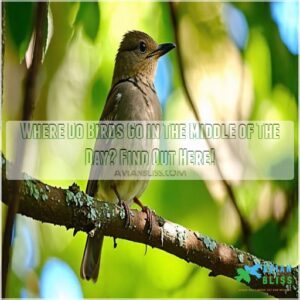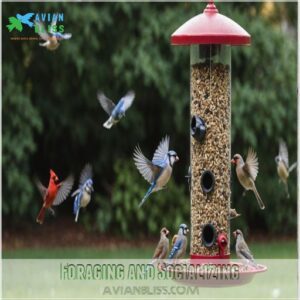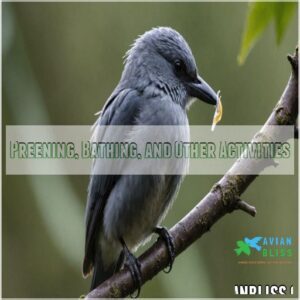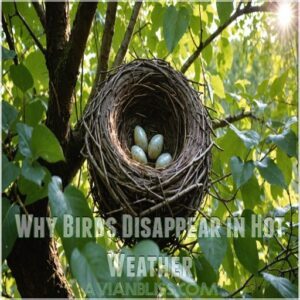This site is supported by our readers. We may earn a commission, at no cost to you, if you purchase through links.

When the sun’s blazing, these feathered fellows often retreat to cooler spots.
You’ll find them nestled in the shade of dense shrubs or taking a quick siesta in tree cavities.
They’ve got an impressive knack for staying cool, all while keeping an eye out for predators.
Some birds flock together, reducing activity to conserve energy and maintain social bonds.
It’s like a midday break room without the snacks!
Curious about how these routines shift with the seasons or which birds are the cleverest at dodging the heat?
Stay tuned!
Table Of Contents
- Key Takeaways
- Birds’ Midday Retreats
- High in The Tree Branches
- Roosting in Numbers Provides More Protection
- What Do Birds Do Midday?
- Where Birds Go to Sleep
- Why Birds Disappear in Hot Weather
- Bird Sleep Patterns and Roosting Habits
- Daily Routines and Seasonal Variations
- Midday Quiet: Reasons Behind The Afternoon Lull
- Best Times for Birdwatching
- Frequently Asked Questions (FAQs)
- Where do birds go midday?
- Where are the birds during the day?
- Do birds sleep in the middle of the day?
- What do birds do midday?
- Do birds eat during the middle of the day?
- How do birds stay hydrated in heat?
- What triggers midday bird activity changes?
- Are midday bird calls common or rare?
- How do birds interact with each other midday?
- Conclusion
Key Takeaways
- You’ll find birds seeking shade in dense shrubs or tree cavities during the hottest parts of the day to conserve energy and avoid predators.
- Birds engage in midday flocking, which enhances foraging success and provides safety in numbers from potential threats.
- You’ll notice decreased bird vocal activity and movement midday as they focus on thermoregulation and conserving energy.
- Birds also take advantage of social interactions, preening, and finding food during the warmer hours, balancing these activities with resting and energy conservation.
Birds’ Midday Retreats
When you’re wondering where birds vanish to in the heat of the day, you’ll find they often seek cooler, shaded spots to escape predators and recharge.
Birds manage their energy by engaging in midday retreats, balancing rest with opportunistic foraging to maintain their energy levels.
Behavioral Changes During The Day
Have you ever wondered about bird behavior?
Midday sees shifts in bird activity patterns. Their daily routines adjust; foraging habits change, influenced by factors like temperature and predation risk.
You’ll notice decreased bird daytime behavior, fewer social interactions, and a quieter atmosphere.
Birds might seek shade, conserving energy.
For example, eastern bluebirds are known to huddle together in tree cavities, and many birds, including bluebirds, exhibit specific behaviors during the middle of the day that help them conserve energy, Understanding these midday roosting habits provides insight into their survival strategies.
These bird midday habits are fascinating aspects of their daily lives.
Midday Napping
Observing birds throughout the day reveals intriguing habits, especially around midday when they seem to engage in behaviors like avian yawning patterns, especially after morning foraging. Observing birds throughout the day reveals intriguing habits, especially around midday when they choose to nap.
Birds’ midday retreats, dictated by bird sleep cycles, point to their unique napping locations.
Such midday habits focus on energy conservation by minimizing movement.
It’s fascinating to think about where birds rest, underscoring the complexity of bird midday roosting.
- Napping locations: seeking shade
- Energy conservation: reduced activity
- Bird daytime behavior: less movement
- Nesting habits: safe spaces
- Predator avoidance: strategic perches
Escape From Heat and Predators
Imagine you’re a bird trying to escape from the midday heat and predators.
Birds cleverly retreat to the shade, taking shelter under dense foliage where temperatures are cooler.
This smart move helps them avoid heat stress and the watchful eyes of predators.
Birds often seek shelter in tree cavities or under dense foliage, utilizing effective shelter strategies such as hiding in tree hollows. It’s a simple yet effective cooling strategy, providing a midday sanctuary that balances bird behavior with survival needs.
Flocking and Foraging Habits
Exploring the midday behavior of birds, you’ll find they often engage in flocking as a strategy to outsmart food competition.
Larger flocks can mean safer foraging and better defense against predators.
It’s a fascinating dance of tactics, from varying flock sizes to shifting locations for the best food sources, all balancing the delicate act of staying nourished and secure.
You can find more information about bird midday habits and how to attract birds to your yard.
It’s a fascinating dance of tactics, from varying flock sizes to shifting locations for the best food sources, all balancing the delicate act of staying nourished and secure.
High in The Tree Branches
When the sun reaches its peak, you might notice birds retreating high into the tree branches, where they find refuge amid leaves and twigs.
This elevated perch offers shade and protection from predators, but it also allows them a vantage point to spot potential threats and food sources.
In Dense Shrubs and Bushes
Many birds find refuge in dense shrubs and bushes during midday, seeking shelter from predators and extreme temperatures.
Here, they benefit from natural camouflage, secure nesting sites, and protection, which is similar to the advantages birds get from tree nesting advantages.
Consider these reasons birds choose this haven:
- Camouflage effectively conceals them from predators.
- Shelter offers protection from harsh weather.
- Nest sites support breeding and resting needs.
In Tree Cavities
While some birds find refuge in dense shrubs, others prefer tree cavities high up in the branches.
These natural shelters offer midday nesting and protect from predators.
The size of the cavity matters, accommodating different species and affecting cavity competition.
This midday sanctuary helps in breeding activities but also requires regular cavity maintenance to remain a safe haven.
Roosting in Numbers Provides More Protection
Many birds dramatically increase their safety by roosting together in large groups; this communal roosting provides a significant advantage against predators, as a larger flock makes it harder for a single predator to successfully target an individual bird.
This strategy also reduces individual vigilance, allowing birds to conserve energy and reduce stress during periods of rest.
Communal Roosting for Safety
Imagine the safety in numbers when birds roost communally.
They find strength, warmth, and protection from predators.
Just as they use their dawn chorus to announce their survival through the night, here’s why communal roosting works:
- Predator Avoidance: More eyes spot danger quickly.
- Flock Dynamics: Group alerts foster swift reactions.
- Communal Warmth: Snuggling in close.
Roost site selection keeps them safe.
It’s bird safety in action!
Reduced Activity Levels
After chatting about communal roosting for safety, you’ll notice birds often hit the pause button, cutting back activity in the midday heat.
This quiet time isn’t just about rest; it’s strategic.
With reduced movement, birds conserve energy and stay cool, avoiding predators by staying hidden.
This behavior highlights their smart adaptation to summer heat, blending survival instincts with energy conservation.
What Do Birds Do Midday?
When you find yourself wondering what birds are up to in the middle of the day, consider that they’re busy foraging for food and socializing with fellow feathered friends, often balancing these activities with important self-care routines like preening or taking quick baths.
These midday tasks help them maintain their plumage, bond with others, and prepare for evening and nocturnal activities.
Foraging and Socializing
During midday, birds get busy with foraging, focusing on finding food sources essential for their survival.
You might see them engaging in lively flocks, where flock dynamics play a role in cooperative hunting and sharing communication signals.
This social behavior isn’t just about survival; it’s also about strengthening bonds, sometimes even involving vibrant mating rituals and intricate vocalizations.
Preening, Bathing, and Other Activities
While birds scavenge for snacks and mingle at midday, they’re also busy with other tasks.
You’ll notice them engaging in preening, a careful dance of feather care and parasite removal.
Some bird species indulge in dust baths to keep their feathers clean and healthy by using a natural remedy for parasite control, as seen in how to build a dust bath for birds, or splashing in puddles, ensuring their plumage stays in excellent condition.
These rituals enhance their nesting behavior and social grooming, highlighting intriguing bird midday routines.
Where Birds Go to Sleep
You might be curious about where birds go to catch some z’s after a busy day of chirping and flying.
Birds have unique sleep strategies:
wading birds stand in shallow water, while waterfowl often choose to float safely on ponds or lakes, ensuring both comfort and protection during their slumber.
Wading Birds Sleep Standing Up
Because wading birds often sleep standing up, you might wonder how they avoid leg fatigue.
It’s all about a clever locking mechanism in their leg joints, conserving energy.
Their sleep cycles are shorter than ours, and they can easily shift their weight.
This unique wading bird sleep posture helps them stay alert to predators while conserving energy, much like hummingbirds use torpor to reduce energy expenditure during cold nights, often hanging upside down while sleeping.
Think of it as a built-in, avian "sleep stand"!
Waterfowl Prefer to Float on The Water
Imagine this: waterfowl simply floating as they snooze—a beautiful dance of nature and sleep.
Their love for water provides:
- Natural buoyancy keeping them afloat
- Water safety from ground predators
- Rest without roosting like trees
- Duck behavior patterns showing preference for water
- Blissful winter roosting often in calm, sheltered lakes
These habits highlight a fascinating adaptation to their environment.
Why Birds Disappear in Hot Weather
When the sun blazes overhead, you might wonder where the birds have gone—rest assured, they’re mastering the art of staying cool.
By expertly managing their body temperature through thermoregulation, birds skillfully avoid the heat while maintaining feather condition.
They seek shade among leaves and branches.
Thermoregulation and Feather Condition
Birds know a thing or two about staying cool when the sun blazes.
Just like you might flop under a fan, they find ways to manage heat stress through clever thermoregulation and feather maintenance, which is why using bird summer tips can be helpful.
Their feathers play a key role in insulation adaptation, protecting against sun exposure impact, and maintaining a perfect balance during those sweltering midday temperatures.
Seeking Shelter and Shade
When it’s scorching, you might wonder where the birds go.
Often, they escape the midday sun by seeking shade under dense tree branches or shrubs.
This behavior, a clever adaptation, helps them avoid heat stress, maintaining a stable body temperature.
In fact, during this time, birds will also take brief naps in the shade of dense foliage or tucked into tree cavities.
It’s not just about hiding; it’s a smart nesting strategy, highlighting their habitat preferences and midday shelter tactics.
Bird Sleep Patterns and Roosting Habits
You might wonder how birds manage their sleep in a world filled with potential danger, and the answer is that they’ve perfected a blend of nighttime roosting and daytime power naps.
By finding cozy spots in trees and shrubs, these feathered creatures can safely catch some Z’s, occasionally during the day, ensuring they conserve energy for their next flight or foraging mission.
Nighttime Roosting in Trees and Shrubs
As the sun fades, birds find solace in nighttime roosting within the protective embrace of trees and shrubs.
These locations offer safety from predators and provide ideal canopy selection for maintaining warmth.
Their roosting behavior involves choosing strategic nest sites, utilizing birdhouses or natural roosting pockets to guarantee protection.
It’s nature’s harmonious way of securing a peaceful night’s rest.
Daytime Napping and Resting
So, you’ve learned about nighttime roosting.
Now, let’s look at daytime rest.
Many birds take short naps, conserving energy between foraging trips, often sleeping on one leg to stay vigilant for predators.
They might fluff their feathers for warmth in sheltered spots like dense shrubs or birdhouses, finding roosting pockets for a quick rest.
Daytime napping strategies vary, depending on the species and environmental conditions.
Safe roosting places are key for energy conservation, ensuring they’re ready for the next adventure.
Daily Routines and Seasonal Variations
As you observe birds throughout the day, you’ll notice their routines shift with changing seasons, impacting their foraging strategies and social interactions.
During warmer months, birds may flock together more often, while in the cooler seasons, they adapt by seeking out different food sources to thrive.
Foraging Strategies and Food Sources
To crack the mystery of bird midday foraging, consider their clever strategies.
Birds juggle unique tactics, adapting to ever-shifting challenges like:
- Food competition intensifies during seasonal changes.
- Insect availability spikes and plummets unpredictably.
- Plant adaptations provide surprising sustenance.
- Food hoarding guarantees survival in lean times.
- Foraging uncovers diverse food sources, essential for each bird species’ survival.
Social Interactions and Flocking
Ever wonder why birds flock together midday?
It’s social behavior at its finest! Birds enjoy the flocking benefits of safety and improved communication.
Within a bird species, social hierarchy determines roles during migration and breeding.
This interaction isn’t just about survival; it’s a complex dance of cooperation and competition, showcasing how birds use their social dynamics to thrive.
Midday Quiet: Reasons Behind The Afternoon Lull
You’ll notice birds tend to quiet down in the afternoon as they focus on thermoregulation and conserving energy during the hottest part of the day.
This lull also coincides with a reduction in their territorial defense and breeding activities, making the midday hours a period of rest and energy preservation.
Thermoregulation and Energy Conservation
Imagine watching birds as they skillfully manage midday heat, maintaining energy efficiency through thermoregulation.
They use four strategies:
- Feather Fluffing: Puffing up feathers to insulate against heat and conserve energy.
- Shade Seeking: Finding natural shelters to avoid direct sunlight.
- Water Bathing: Cooling down to reduce heat stress.
- Minimal Movement: Conserving energy during high temperatures.
These tactics help birds thrive even under the blazing sun.
Reduced Territorial Defense and Breeding Activities
While birds conserve energy by managing heat, they often lower their territorial defense and breeding activities midday.
This lull leads to less aggressive behavior and fewer territorial songs, as the need for nestling care and mating season decreases.
Flocking behavior takes center stage with social interactions, while brood parasitism becomes less of a concern, creating a quiet ambiance during midday.
When looking for unique gifts related to this phenomenon, consider checking out bird midday quiet products.
Best Times for Birdwatching
To maximize your birdwatching success, remember that dawn and dusk are prime viewing times, as birds are most active then.
eBird can help you pinpoint locations and times with the highest likelihood of bird sightings, enhancing your birding experience.
Dawn and Dusk Peaks in Activity
At dawn and dusk, you’ll notice a flurry of bird activity. It’s the best time to grab your binoculars and immerse yourself in nature’s show.
Birds are busy with:
- Bird song that fills the air
- Foraging for an energetic start or end
- Migrating under the cover of twilight
- Breeding behaviors
- Nesting duties
Each moment offers a diurnal or nocturnal spectacle worth watching.
Using EBird to Track Bird Movements
Harness the power of eBird to track bird movements and discover the best times for birdwatching, keeping in mind that favorable weather conditions such as mild temperatures and light winds greatly impact bird activity.
As a tool for citizen science, it offers detailed data visualization of migration routes, species distribution, and seasonal patterns.
Explore migratory patterns and range, ensuring your adventures align perfectly with peak avian activity periods.
Frequently Asked Questions (FAQs)
Where do birds go midday?
Birds often seek temporary cover under shrubs and bushes to stay dry during heavy rain, which can be achieved with the help of natural structures for rain. Birds often seek sheltered spots like trees or shrubs to rest during midday heat.
This allows them to conserve energy, avoid predators, and reduce exposure to excessive sun, ensuring they maintain their strength and health.
Where are the birds during the day?
Like an old clock’s tick-tock, birds find perch spots, rest or forage during the day.
They seek shady trees or safe branches to conserve energy and avoid predators, enjoying short naps or searching for food.
Do birds sleep in the middle of the day?
Most birds are diurnal, active during the day. They don’t typically sleep midday; instead, they forage, preen, and socialize. Nocturnal birds, however, sleep during the day.
What do birds do midday?
During midday, birds often engage in activities like foraging for food, resting in shaded areas to conserve energy, or preening to maintain their feathers.
Some might also engage in social interactions or territorial behaviors.
Do birds eat during the middle of the day?
Birds often eat during the middle of the day, although it depends on the species and their eating habits.
Some birds take advantage of the sun’s heat to forage, while others rest during the hotter hours.
How do birds stay hydrated in heat?
Think of birds as tiny survivalists!
They stay hydrated by sipping water from ponds and streams, munching on juicy fruits and insects, and even extracting moisture from food.
During extreme heat, they pant to cool off.
What triggers midday bird activity changes?
You might notice changes in bird activity midday due to temperature shifts, food availability, and predation risks.
As temperatures rise, birds seek shade or water, altering their feeding patterns to conserve energy and stay cool.
Are midday bird calls common or rare?
About 60% of diurnal birds reduce vocal activity at midday, although it’s not rare; some species still call to communicate or defend territories.
Typically, birds conserve energy and avoid predators during this hotter, quieter period.
How do birds interact with each other midday?
Instead of constant chatter, birds interact midday through subdued calls, subtle movements, and grooming.
They focus on finding food and shade, often forming small flocks or pairs, conserving energy during the hotter parts of the day.
Conclusion
Ironically, while we might think birds are constantly active, understanding where do birds go in the middle of the day reveals a fascinating world of avian behavior.
Their midday routines, dictated by temperature and predation risks, involve seeking shade in dense shrubs or tree cavities.
This isn’t laziness; it’s efficient energy management.
Flocking behavior further enhances safety and reduces heat stress.
Observing these midday retreats provides valuable insights into their survival strategies and daily rhythms.
So next time you see a quiet patch in the avian world, remember, it’s not emptiness, but a calculated strategy.















